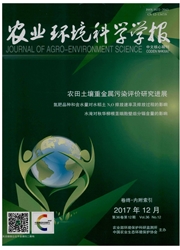

 中文摘要:
中文摘要:
利用^109Cd^2+示踪技术.以水稻为指示植物。根据苄嘧磺隆的商业推荐施用量200~400g·hm^-2,研究了苄嘧磺隆施用量分别为0、200、300、400和600g·hm^-2时,对重金属元素Cd的生物有效性影响。结果表明,水稻植株对^109Cd^2+的吸收能力较强,但主要分布在根系。占植株总吸收量的92.8%。94.4%。根系中Cd的富集系数(根中Cd的比活度,溶液中Cd的比活度)为0.612~0.813;茎叶中Cd的富集系数(茎叶中Cd的比活度,溶液中Cd的比活度)为0.036-0.054。当苄嘧磺隆施用量为200、300g·hm^-2时,水稻对^109Cd^2+的吸收总量比对照有减少的趋势。当施用量为200、300和400g·hm^-2时,根部吸收^109Cd^2+有逐渐增加的趋势,在施用量为400g·hm^-2时,水稻根部吸收^109Cd^2+的比活度分别与施用200、300g·hm^-2相比,有显著增加(P〈0.01)趋势,这表明苄嘧磺隆对水稻根系吸收Cd有一定的刺激作用,然而同样的处理在茎叶中增加的趋势没有显著性差异(P〈0.01)。当苄嘧磺隆使用量为600g·hm^-2时,水稻根系及茎叶吸收^109Cd^2+的比活度明显降低(P〈0.01),主要是因为苄嘧磺隆的降解产物达到一定浓度并与镉可能形成有机金属配合物,从而降低了Cd的生物有效性。试验结果还表明,茎叶吸收的^109Cd^2+分别比对照和其他处理浓度时的吸收量显著降低了(P〈0.05),这是因为有机金属配合物的长距离运输比较困难,使大量的有机金属配合物富集在根系中。
 英文摘要:
英文摘要:
^109Cd^2+ trace technique was used to evaluate the effect of bensulfuron methyl (BSM) on the phytoavailability of Cd to rice. Treatments of BSM were tested as the concentrations of 0 g·hm^-2, 200 g·hm^-2, 300 g·hm^-2, 400 g·hm^-2 and 600 g·hm^-2 in quadruplications, respectively, according to the commercial recommendations of 200 g·hm^-2 to 400 g·hm^-2. Cadmium was applied as 5 mg·L^-1 with cadmium chloride. The result indicated that the uptake of ^109Cd^2+ by rice was obvious high but 92.8%-94.4% of them distributed in the root. The concentrating factor of the root (specific activity of ^109Cd^2+ in root Bq·kg^-1/specific activity of ^109Cd in solution Bq·L^-1) arrived to 0.612-0.813 and the stem 0.036-0.054 (specific activity of ^109Cd in stem Bq·kg^-1/specific activity of ^109Cd in solution Bq·L^-1). The uptake of ^109Cd^2+ by the root increased varying with the concentration of BSM in the extension of 200 g·hm^-2, 300 g·hm^-2 and 400 g·hm^-2, and it reached a significant difference at 400 g·hm^-2 (P〈0.01), which indicated that a stimulation of BSM to absorb Cd^2+ for rice may existe there. Moreover, there was no significant difference for the uptake by the stem (P〈0.01) in the same treatments. While the application of BSM arrived to 600 g·hm^-2 the uptake of ^109Cd^2+ by the root and the stem decreased significantly (P〈0.01) comparing with that of the treatment of 400 g·hm^-2. It seemed that a organic-metal compound of Cd with the metabolic product of BSM formed to cause the phytoavailability of Cd being debased. Meanwhile the uptake of ^109Cd^2+ by the stem decreased significantly (P〈0.05) comparing with that of control and other treatments respectively. It appeared that long-distance transportation for organic-metal compound was difficulty therefore most of them were enriched in the root.
 同期刊论文项目
同期刊论文项目
 同项目期刊论文
同项目期刊论文
 期刊信息
期刊信息
